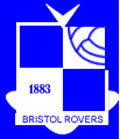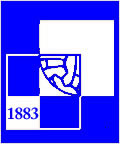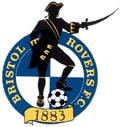Bristol Rovers
In September 1883 a group of young men formed a football club and decided to call it Black Arabs FC. They played at Purdown in East Bristol and became known as the "Purdown Poachers" due to their habit of persuading players of other clubs to join them. The following year they changed their name to Eastville Rovers and in 1892 they joined the Bristol & District League. By the summer of 1895, Eastville Rovers were based at the Star Inn on Fishponds Road and played all their home matches at the Ridgeway Ground in, according to Byrne, Stephen & Jay a "a kit of buff and green." As no photographs of this unusual outfit exist I have used artistic licence to present it here. In 1897 the club turned professional and became Bristol Eastville Rovers: the following year "Eastville" was dropped and they became known as Bristol Rovers. In 1899 the club joined the Southern League, winning the championship in 1905. In 1920, Rovers became founder members of the Football League Third Division along with the rest of the Southern League Division One clubs.
Rovers hardly set the world alight and remained an average to poor Third Division team until the 1950s. In 1931, the club adopted blue and white quartered shirts: the manager believed that this design would make his players look bigger. This strip has since become synonymous with the club. In March 1940 the club, faced with financial problems, sold their Eastville Stadium to the Bristol Greyhound Company and thereafter rented their ground. This decision would come back to haunt the club some forty years later.
In 1953 the Pirates won the Third Division (South) championship and took their place in Division Two and for the rest of the decade the club were firmly established in the top half of the division. In 1962 Rovers were relegated to the Third Division. During the Sixties the cherished quartered shirts were dropped in favour of striped shirts and later plain blue. It is fitting that the side that won promotion in 1974 did so wearing quartered shirts that had been revived the previous season.
 Rovers' shirts were, perhaps, considered sufficiently distinctive for the club to eschew wearing their crest during the Seventies, when these began to return to fashion. In 1979 BRFC was embroidered in white on the upper left (blue) quarter and in 1980 a crest finally did appear, a fairly straightforward design that incorporated the traditional quartered motif and the year of their formation. This first appeared set on a white roundel but from 1981 it was embroidered directly on to the shirt. This was replaced in 1988 by a modified version. Throughout the period these badges were used, the upper left quarter was always blue.
Rovers' shirts were, perhaps, considered sufficiently distinctive for the club to eschew wearing their crest during the Seventies, when these began to return to fashion. In 1979 BRFC was embroidered in white on the upper left (blue) quarter and in 1980 a crest finally did appear, a fairly straightforward design that incorporated the traditional quartered motif and the year of their formation. This first appeared set on a white roundel but from 1981 it was embroidered directly on to the shirt. This was replaced in 1988 by a modified version. Throughout the period these badges were used, the upper left quarter was always blue.
In August 1980 the South Stand burnt down and Rovers played five "home" matches at Ashton Gate before they were able to return to Eastville the following month.
The team made little headway at the higher level and in 1981 they were back in Division Three. In April 1986, faced with mounting debts and increasing rental payments, the club moved away from Bristol to share Bath City's Twerton Park ground. Many believed that their days were numbered but they survived and ten years later, with Gerry Francis in charge, Rovers were promoted once again and spent three seasons in Division Two before the inevitable relegation in 1993.
During the Eighties and Nineties, considerable imagination was applied to producing variations on the basic quartered shirts. The 1996 version, however, was universally despised and nicknamed "The Tesco Bag" for reasons that are obvious.
 In 1996 Rovers entered into a ground sharing agreement with Bristol Rugby and returned to their home city to play at the Memorial Ground, known locally as "The Mem." Within a few years, the rugby club fell on hard times and Rovers were able to buy out their interest in the ground for a mere £10,000.
In 1996 Rovers entered into a ground sharing agreement with Bristol Rugby and returned to their home city to play at the Memorial Ground, known locally as "The Mem." Within a few years, the rugby club fell on hard times and Rovers were able to buy out their interest in the ground for a mere £10,000.
A redesigned crest was adopted in 1997, incorporating for the first time the figure of a pirate, to reflect Rovers' official nickname of "The Pirates", which reflects the city's maritime heritage. Understandably the club preferred to adopt this identity rather than their more colloquial local nickname, "The Gas," which derives from the term "Gasheads," coined by City supporters and adopted by Rovers' supporters in the Eighties. The term comes from the days when Rovers' old Eastville ground was frequently filled with the overpowering smell from the neighbouring town gas works.
In 2001 Rovers dropped into Nationwide Division Three the first time that the club has been in the lowest division since their Division Three (South) days. In the early years of the new millennium the club struggled, narrowly avoiding the drop into the Conference.
In 2007, planning permission was granted to redevelop The Memorial Ground as a 18,500 all-seat stadium but work was delayed by the withdrawal of the club's principal partner and the economic recession. After further delays it was announced in June 2011 that the Memorial Ground site would be sold to Sainsbury's and the funds used to build a 20,000 seat stadium in the grounds of the University of the West of England campus in Frenchay.
